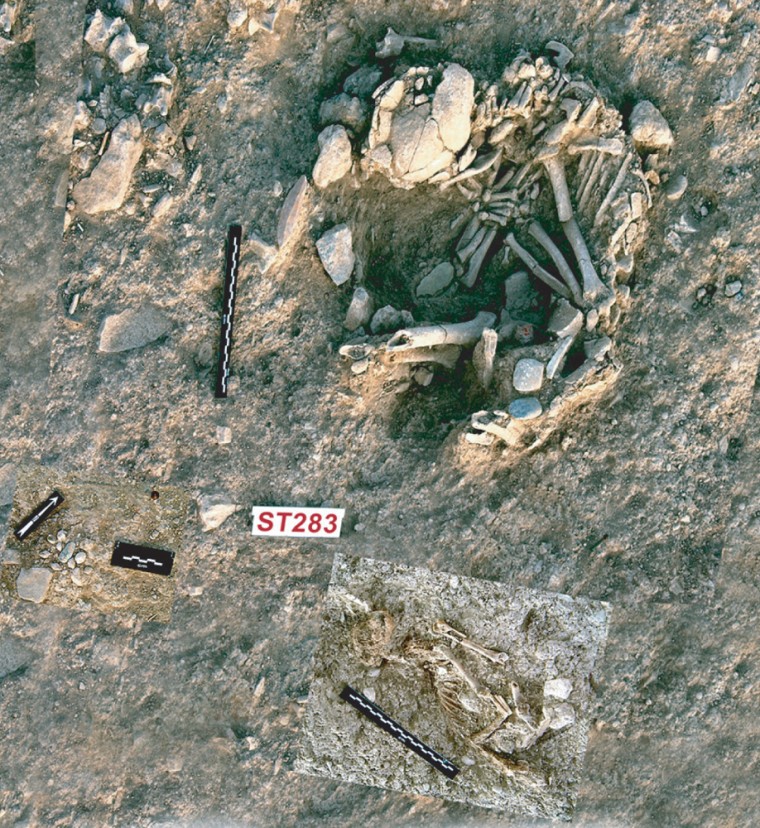That contented calico purring away on the sofa may be the product of a human-feline friendship extending 9,500 years or more into the past.
While ancient Egypt provides the first written record of cats, a burial discovered on Cyprus indicates that humans and felines may have become associated much earlier.
It’s a relationship that has ranged from their being adored as gods in the Nile valley to their slinking into medieval witchhood and rising again to be revered in poet T.S. Eliot’s verses and in the stage show “Cats.” Today, more than 30 percent of American homes host a cat.
Jean-Denis Vigne of the National Museum of Natural History in Paris believes the relationship first blossomed with the development of agricultural societies 10,000 or so years ago.
“It seems that cats probably came more and more frequently into villages where grain stocks attracted numerous mice,” said Vigne. “I think that human beings rapidly understood that they could use cats for reducing the number of mice.”
Buried alongside human
It was Vigne’s research team that uncovered the carefully buried cat on Cyprus, placed just inches from a human burial that also contained polished stones, shells, tools and jewelry. The graves are estimated to be 9,500 years old.

The cat belonged to the Felis silvestris species, a wild cat, which was significantly larger than modern domestic cats. The cat’s bones were placed carefully, parallel to the human, and showed no signs of butchering, another indication that the animal may have been a pet, Vigne said in a paper in Friday’s issue of the journal Science.
The finding seems to be evidence of cats being tamed earlier than previously thought, said Melinda Zeder of the Smithsonian Institution’s National Museum of Natural History.
If the cat was intentionally buried with the human, which it seems to have been, Zeder said, “what they’ve got is pretty good evidence of a kind of relationship with humans.”
It’s hard to know whether it was a pet or a working mouser because “the bones aren’t talking,” said Zeder, president of the International Council for Archaeozoology.
What may be surprising is that there hasn’t been evidence of an earlier relationship with cats, she added, noting that indications of human-dog relations go back 12,000 years.
Blaire Van Valkenburgh, a biology professor at the University of California at Los Angeles, agreed that the finding is “the first suggestion that there was a significant emotional attachment” between a human and a cat.
“They make a good case that they were buried at the same time and it shows that whoever buried it cleared a special spot for it,” she said. “That makes it significant.”
Vigne noted in his paper that there have been older remains of cats — specifically a jaw — found on Cyprus, but it was not associated with a human grave. Cat bones about 9,000 years old were also found near Jericho, but there was no indication of domestication, though that may have been under way in several places at about the same time.
Brought to Cyprus
Cats are not native to Cyprus, so their presence on the eastern Mediterranean island indicates they were brought there at some point.
“The first discovery of cat bones on Cyprus showed that human beings brought cats from the mainland to the islands, but we couldn’t decide if these cats were wild or tame. With this discovery we can now decide that these cats were linked with humans,” Vigne said.
The best known ancient evidence of cats comes from Egypt, where the animals were bred 4,000 or more years ago. Cats were often included in Egyptian art and worshipped as the cat goddess Bastet.
Stones engraved with images of wild cats and other animals have been discovered from Western Asia and dated back to the Early Neolithic — 4000 to 3000 B.C.
This may be evidence that cats had spiritual significance for humans, according to Vigne, though the real meaning of the representations is irreparably lost.
